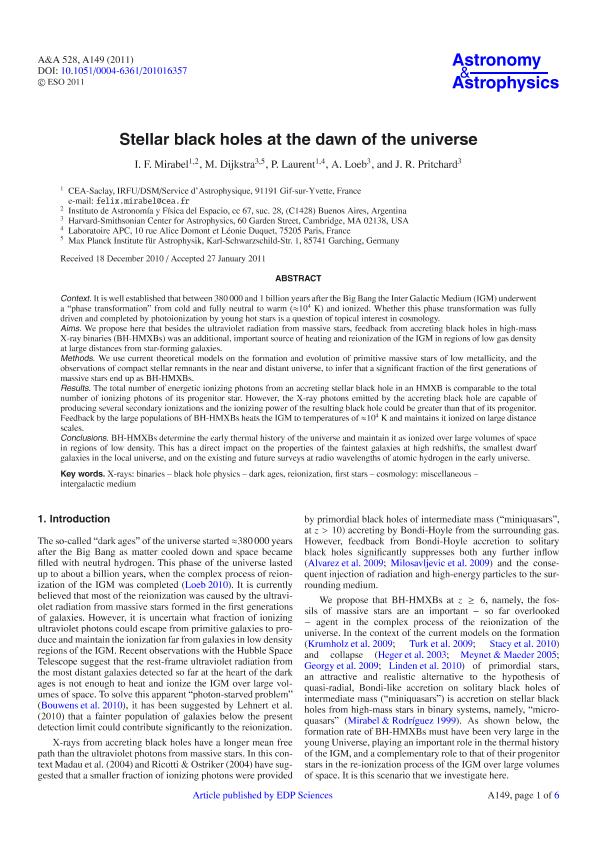Mostrar el registro sencillo del ítem
dc.contributor.author
Mirabel Miquele, Igor Felix

dc.contributor.author
Dijkstra, M.
dc.contributor.author
Laurent, P.
dc.contributor.author
Loeb, A.
dc.contributor.author
Pritchard, R.
dc.date.available
2017-07-06T20:31:05Z
dc.date.issued
2011-04
dc.identifier.citation
Mirabel Miquele, Igor Felix; Dijkstra, M.; Laurent, P.; Loeb, A.; Pritchard, R.; Stellar black holes at the dawn of the universe; EDP Sciences; Astronomy and Astrophysics; 528; 4; 4-2011; A149,1-6
dc.identifier.issn
0004-6361
dc.identifier.uri
http://hdl.handle.net/11336/19817
dc.description.abstract
Context. It is well established that between 380 000 and 1 billion years after the Big Bang the Inter Galactic Medium (IGM) underwent a “phase transformation” from cold and fully neutral to warm (≈ 104 K) and ionized. Whether this phase transformation was fully driven and completed by photoionization by young hot stars is a question of topical interest in cosmology. Aims. We propose here that besides the ultraviolet radiation from massive stars, feedback from accreting black holes in high-mass X-ray binaries (BH-HMXBs) was an additional, important source of heating and reionization of the IGM in regions of low gas density at large distances from star-forming galaxies. Methods. We use current theoretical models on the formation and evolution of primitive massive stars of low metallicity, and the observations of compact stellar remnants in the near and distant universe, to infer that a significant fraction of the first generations of massive stars end up as BH-HMXBs. Results. The total number of energetic ionizing photons from an accreting stellar black hole in an HMXB is comparable to the total number of ionizing photons of its progenitor star. However, the X-ray photons emitted by the accreting black hole are capable of producing several secondary ionizations and the ionizing power of the resulting black hole could be greater than that of its progenitor. Feedback by the large populations of BH-HMXBs heats the IGM to temperatures of ≈ 104 K and maintains it ionized on large distance scales. Conclusions. BH-HMXBs determine the early thermal history of the universe and maintain it as ionized over large volumes of space in regions of low density. This has a direct impact on the properties of the faintest galaxies at high redshifts, the smallest dwarf galaxies in the local universe, and on the existing and future surveys at radio wavelengths of atomic hydrogen in the early universe.
dc.format
application/pdf
dc.language.iso
eng
dc.publisher
EDP Sciences

dc.rights
info:eu-repo/semantics/openAccess
dc.rights.uri
https://creativecommons.org/licenses/by-nc-sa/2.5/ar/
dc.subject
Black Holes
dc.subject
Astronomía
dc.subject.classification
Astronomía

dc.subject.classification
Ciencias Físicas

dc.subject.classification
CIENCIAS NATURALES Y EXACTAS

dc.title
Stellar black holes at the dawn of the universe
dc.type
info:eu-repo/semantics/article
dc.type
info:ar-repo/semantics/artículo
dc.type
info:eu-repo/semantics/publishedVersion
dc.date.updated
2017-07-06T13:03:22Z
dc.journal.volume
528
dc.journal.number
4
dc.journal.pagination
A149,1-6
dc.journal.pais
Francia

dc.journal.ciudad
Paris
dc.description.fil
Fil: Mirabel Miquele, Igor Felix. Consejo Nacional de Investigaciónes Científicas y Técnicas. Oficina de Coordinación Administrativa Ciudad Universitaria. Instituto de Astronomía y Física del Espacio. - Universidad de Buenos Aires. Facultad de Ciencias Exactas y Naturales. Instituto de Astronomía y Física del Espacio; Argentina
dc.description.fil
Fil: Dijkstra, M.. Harvard-Smithsonian Center for Astrophysics; Estados Unidos
dc.description.fil
Fil: Laurent, P.. Centre D; Francia
dc.description.fil
Fil: Loeb, A.. Harvard-Smithsonian Center for Astrophysics; Estados Unidos
dc.description.fil
Fil: Pritchard, R.. Harvard-Smithsonian Center for Astrophysics; Estados Unidos
dc.journal.title
Astronomy and Astrophysics

dc.relation.alternativeid
info:eu-repo/semantics/altIdentifier/url/https://www.aanda.org/articles/aa/abs/2011/04/aa16357-10/aa16357-10.html
dc.relation.alternativeid
info:eu-repo/semantics/altIdentifier/doi/http://dx.doi.org/10.1051/0004-6361/201016357
dc.relation.alternativeid
info:eu-repo/semantics/altIdentifier/url/https://arxiv.org/abs/1102.1891
Archivos asociados
